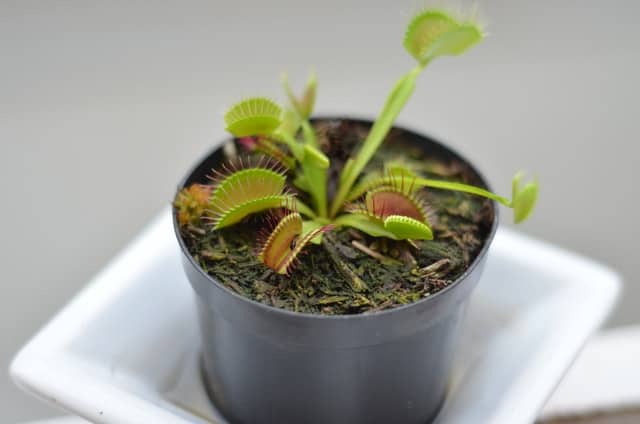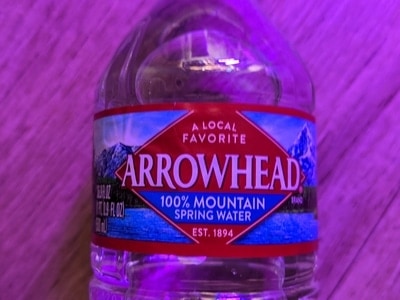Some water types are suitable for Venus flytraps, others can be harmful and end up killing the plant. Spring water is available in most grocery stores and gas stations but, is it safe for Venus flytraps?
Spring water can be safe for Venus flytraps if it contains less than 50 parts per million (ppm). Spring water with ppm readings over 50 or 100 ppm can be harmful to Venus flytraps. Test the water before using or employ pure water sources.
This article will guide you through the steps to find the correct water for your plant.
If you have already used the incorrect water source for your plant, make sure to read this article: How to Save a Venus Flytrap After Watering With Tap Water (or other unsuitable sources). It will guide you through steps and help you ensure your Venus flytrap recovers.
Is Spring Water Suitable for Venus Flytraps?
The minerals present in most spring water are harmful to Venus flytraps and other carnivorous plants.
Venus flytraps are intolerants to minerals that are commonly present in rich soil and potable water. The minerals build up in the soil and weaken the plant. For that reason, not all water is safe for Venus flytraps.
Spring water can be safe for Venus flytraps if it contains less than 50 ppm. A ppm reading between 50 and 100 ppm is acceptable but not recommended. Optimal water sources contain 0 ppm.
The composition and quality of spring water vary significantly, as it can come from many different sources and might be purified or not.
To verify spring water is safe for Venus flytraps, you must test it.
You can employ a Total Dissolved Solids (TDS) Meter to asses the ppm levels in spring water and other water sources.
I recommend buying a TDS meter for all carnivorous plant growers or hobbyists. TDS meters are very inexpensive (less than $15) and easy to use. Here is a link to the one I use; you can check its current price on the Amazon website by following the link.
TDS meters will help you verify the water you employ is safe for your Venus flytrap and can potentially save them from mineral burns and death. Yellow leaves are a common sign of mineral burns on Venus flytraps.
Using a TDS meter is very simple:
- Add the water you want to test in a clean container.
- Grab the TDS meter and turn it on
- Dip the bottom end in the water
- And that is it! A ppm reading should appear on the screen.
A value below 50 ppm indicates the water is suitable for flytraps and other carnivorous plants. A reading between 50 and 100 ppm is acceptable but not optimal. A lower reading is always better.
I used a TDS meter to test ARROWHEAD Spring Water, and got a reading of 130 ppm. Even though such water might good drinking water, it will harm and kill Venus flytraps.
How to Reduce PPM Measurement in Spring Water
The ppm reading for your spring water might on the suitable or acceptable range for Venus flytraps, but it is still beneficial to get to lower the number of dissolved solids. Here are some strategies to eliminate the extra components in the water.
- Filter the water: If you have a water filter, use it. Britta or similar filters can reduce the number of ppm in your Spring water. I recently bought a ZeroWater filter pitcher. The filter reduces the number of dissolved solids in the water to zero ppm, regardless of its source. Here is a link to buy a ZeroWater pitcher filter and check its specs and current price. The pitcher filter includes a TDS meter and one filter.
- Let the water rest in an open container overnight: Some water solids can evaporate over time. One night or a day is enough to eliminate some components.
Water Alternatives for Venus Flytraps Besides Spring Water
Safe Water Options for Venus Flytraps
Not all water is suitable for carnivorous plants. But, buying or collecting water for your plants should not be a hassle. The options described in this section are 100% safe for your plant.
Rainwater, reverse osmosis water, and distilled water is pure water, safe for Venus flytraps. Pure water sources do not contain minerals and additives that harm carnivorous plants. Tap water and bottled water is usually harmful to Venus flytraps
These three water sources are always safe for Venus flytraps:
Rainwater: Rainwater is the only free option on this list. If you have access to frequent rainy days, you should consider collecting rainwater and using it for your plants. Rainwater contains zero or little ppm(<50 ppm).
Reverse osmosis water: RO water is sometimes sold in grocery and water stores. It costs about a dollar or a dollar fifty a gallon and contains 0 ppm
Distilled water: This option is available almost everywhere, and it is inexpensive. You can buy a gallon of distilled water for less than one dollar in most supermarkets. Select the generic distilled water jug.
When buying distilled water, read the label. Make sure the water you are selecting is pure. Water might be purified through a distillation process, but if it contains added minerals, then the water is harmful to Venus flytraps. If the label says anything like the text below, avoid it (it is not pure distilled water):
- with additives
- with minerals for taste
- with electrolytes
- added minerals
Unsafe Water for Venus Flytraps
Using the incorrect water source for Venus flytraps can kill them. Make sure to avoid these:
Tap Water: Tap water is not usually safe for Venus flytraps. I employed a TDS meter to measure the tap water in my house, and I was shocked.
The ppm reading for my tap water was over 500! So, tap water in my house would kill my carnivorous plants very quickly.
Boiled Tap Water: Boiling tap water does not make it safe for Venus flytraps. The boiling process increases the concentration of dissolved solids in the liquid, making it less safe for carnivorous plants.
Bottled Water: Bottled water is not always harmful to Venus flytraps, but it can be depending on its compositions. Most bottled water contains minerals and electrolytes, useful to add taste. To be safe, always test bottled water before using it for your plants.
I used a TDS meter to measure SmartWater, and the reading was within the acceptable levels for Venus flytraps. SmartWater had less than 30 ppm.
Never employ water with more than 100 ppm for Venus flytraps. High mineral contents produce mineral burns, weakens and kills Venus flytraps.
Easy Venus Flytrap Watering Instructions
Watering Venus flytraps incorrectly can kill the plant. Underwatering and overwatering are very harmful. Also, using the correct water source is critical.
Follow this instructions to always water you Venus flytrap correctly and keep it safe:
- Employ pure water sources, such as distilled water, ro water, or rainwater
- Keep the humidity levels high: Venus flytraps thrive in humid environments. Water your plant often to keep them happy. Water your plant throughout until the soil is humid all around. Do not flood the soil, but keep it moist at all times.
- Water your Venus flytrap the right amount: After watering, use your finger to sense the humidity in the soil. The ground should be humid but not soaking wet.
- Do not underwater: Never let the soil dry out completely. When Venus flytraps are underwater, they get droopy, weaken, and can die quickly without moisture.
- Do not overwater: Venus flytraps like humid environments, but they do not grow in swamps or ponds. Do not water the soil until it is entirely soaked. It should be moist but not flooded.
- Use the water tray method: The water tray method (watering from the bottom) is a prevalent watering technique to keep carnivorous plants ina moist but not overwatered environment. The picture below illustrates the concept. I highly recommend it! You can read this article (Venus Flytraps Sit in Water) to learn how it works.
- Do not grow Venus flytraps in terrariums: Planting your Venus flytrap in a terrarium provides a humid environment, which is beneficial, but Venus flytraps do not thrive in terrariums. Water can tend to stay in the soil for long periods and cause root rot and mold issues.

This guide can help you master the watering process by following some simple steps: Venus Flytrap Watering Instruction Guide. It detailed tips to teach you how to water your plant the right amount. Also, it gives you tips to adjust the watering through the seasons and life stages of your plant.
The watering process is important for Venus flytraps, but you should consider other factors to keep your plant alive and healthy.
Do not waste time browsing through the web for scattered Venus flytrap care information. This article contains all you need to know to grow Venus flytraps: Ultimate Venus Flytrap Care Guide. Also, for Venus flytraps growing indoors, follow this guide: Venus Flytrap Indoor Care Guide.


